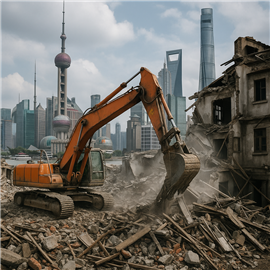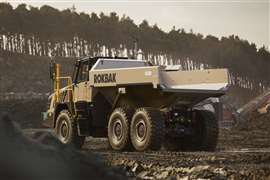Inside East Asia’s demolition divide
25 July 2025
From urban regeneration to waste recycling mandates, East Asia’s demolition and C&D sectors are a hive of activity and innovation. But a lack of integration and transparency may be slowing its progress and masking opportunities for contactors and OEMs.
 Image generated by AI
Image generated by AI
East Asia’s demolition industry is at a turning point. Japan, South Korea and China are each pursuing their own path to modernisation, sustainability and urban renewal—but they are doing so with little regional cohesion, minimal cross-border collaboration, and widely varying degrees of visibility.
For equipment suppliers, consultants and contractors outside the region, it can be difficult to identify opportunities or even track activity with confidence.
This fragmented picture is not just a challenge for journalists and analysts. It reflects deeper structural realities about how demolition is viewed in each country.
In China, the industry is driven by mass-scale redevelopment and reactive infrastructure teardown. In Japan, it is precise, regulatory-driven, and often slowed by heritage preservation and community resistance.
In South Korea, it sits in a tense middle ground between policy ambition and economic contraction.
China’s demolition drive
Demolition is happening everywhere in China’s built environment, but detailed reporting is rare. In 2024 and 2025, projects like the dismantling of Zhuhai’s tram line and Liuzhou’s suspended monorail development illustrated a shift toward reclaiming space from underperforming transit systems.
These moves reflect broader trends: many older urban transit and housing developments are being removed or redeveloped to make way for denser, more commercially valuable infrastructure.
Perhaps the most ambitious example is China’s urban village redevelopment scheme, which expanded from 35 pilot cities to nearly 300 in late 2024.
The demolition of older, informal housing stock is central to this programme but, from a Western perspective, project documentation is inconsistent, with most project works going underreported.
Demolition contractors may be involved in some of the largest urban transformations of the decade—without any clear public visibility.
Meanwhile, C&D waste remains a major concern. Although China’s Ministry of Housing and Urban-Rural Development has issued policies to improve construction waste recycling, actual enforcement is thought to be uneven.
The infrastructure to handle growing C&D waste volumes appears underdeveloped in many cities. This gap between demolition volume and waste processing capacity is creating environmental and logistical pressures that have yet to be fully addressed.
The lack of open data and centralised reporting continues to frustrate suppliers and analysts. For OEMs and service providers outside the country, identifying reliable local partners or market entry points remains challenging.
Most insights into demolition activity come from satellite analysis, isolated media reports, or on-the-ground commercial relationships. Transparency remains a critical barrier.
The impact of regulation on demolition in Japan
Meanwhile, Japan’s demolition sector is mature and tightly regulated. It is also deeply interwoven with issues of cultural preservation, safety, and environmental performance.
For example, the redevelopment of the Imperial Hotel in Tokyo—a project that involves dismantling part of a historically significant building— has raised both interest and concern.
Scheduled for phased completion into the 2030s, it exemplifies Japan’s methodical, long-term approach to urban renewal. Elsewhere in Tokyo, the transformation of the Tokyo Expressway (KK Route) into an elevated urban park known as the Sky Corridor signals a shift in priorities.
Former transport infrastructure is being repurposed into pedestrian and green space, and demolition is the necessary first step. Such projects are designed to make dense urban environments more liveable, but they also highlight how demolition serves a higher-order function in Japan’s planning philosophy.
In Osaka, the demolition of the Osaka Maru Building and its replacement with a taller, mixed-use tower represents a more commercial redevelopment model.
Japan’s cities are experiencing pressure to densify and modernise while balancing seismic risk, accessibility, and aesthetic continuity. Environmental demolition is another area where Japan is moving cautiously but firmly.
The dismantling of the Hamaoka Nuclear Power Plant’s Unit 2 reactor began in March 2025—the country’s first such full decommissioning operation of its kind.
Nuclear dismantling requires exceptional precision, training, and public oversight, and it may represent a small but growing niche within Japan’s demolition sector as more ageing reactors are retired.
However, these developments occur within a broader context of societal sensitivity. The planned redevelopment of Jingu Gaien Park has attracted opposition due to the proposed loss of mature trees and historic sports facilities.
In Japan, demolition is not just a technical act; it is a cultural and civic issue, often requiring prolonged consensus-building.
South Korea C&D waste recycling policies
Meanwhile, South Korea’s demolition industry sits at a complex intersection of ambition and constraint. The country has some of the strongest C&D waste recycling policies in the region, but enforcement varies across jurisdictions, and market conditions are increasingly difficult.
The construction industry as a whole is contracting. According to Research and Markets, real-term output dropped by 1.9% in 2024, and forecasts suggest a further decline of 1.2% in 2025.
Developers face tighter credit, higher input costs, and shrinking demand in the residential sector. These pressures inevitably flow through to demolition contractors, many of whom rely on redevelopment cycles and public works for continuity of work.
Despite this, the excavation and demolition sector is forecast to grow modestly, driven by urban redevelopment schemes and rising environmental compliance costs.
The government’s is inconsistent, and small contractors often lack the resources to fully comply. The country is also scaling up its C&D waste treatment capacity.
There is growing policy support for the use of recycled aggregates in public construction, and private operators are investing in more advanced sorting and recycling systems.
However, without greater market incentives, progress will likely remain piecemeal.
Demolition in East Asia: A divided landscape
If there is one shared characteristic across the demolition sectors in these countries, it is how siloed each remains from each other (and from rest of the world).
Each country operates with its own legal frameworks, safety standards, waste recycling systems, and industry associations. There is little in
the way of regional coordination or shared learning, despite facing many of the same challenges.
While China leads the region in demolition volume, its opacity limits outside involvement. Japan, by contrast, is methodical and highly transparent, but its pace and public sensitivities make it difficult for international firms to scale quickly.
South Korea occupies a grey area—relatively open to international ideas and investment, but constrained by local conditions. For demolition professionals and equipment suppliers looking at East Asia for opportunities, this means navigating a complex set of conditions.
Equipment demand remains strong in some segments, but sales vary widely by market. Understanding local regulations, partnering with domestic firms, and monitoring city level developments are essential for any seeking entry or expansion in the region.
As cities grow denser and environmental regulation tightens, the role of demolition in shaping East Asia’s urban future will only grow. But until the industry becomes more open and interconnected, much of that change will continue to happen out of sight.
STAY CONNECTED


Receive the information you need when you need it through our world-leading magazines, newsletters and daily briefings.
CONNECT WITH THE TEAM










